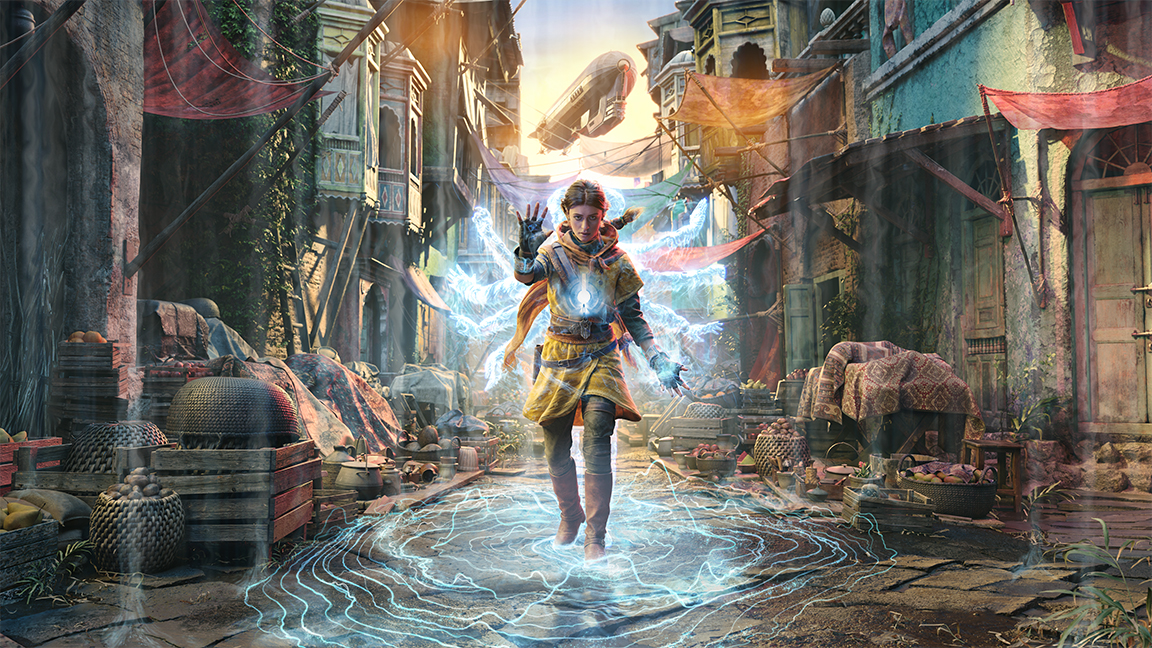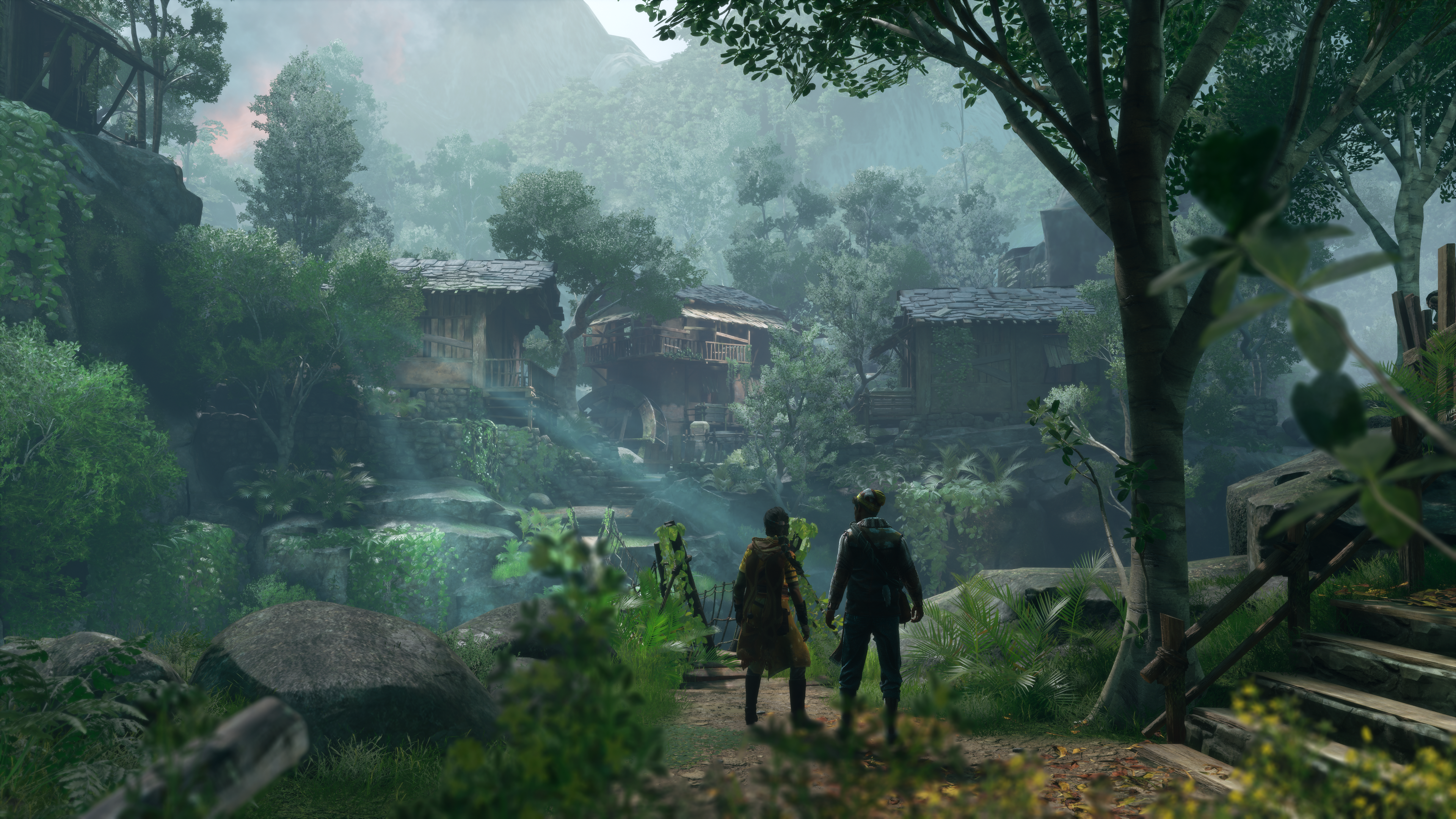
Unreal Engine has been a boon to many AA developers this generation, whether running on the newer UE5 or the tail-end UE4 release, with games like Unknown 9: Awakening embracing the tools found in Epic's game engine to bring to life new experiences that could easily be left behind in the modern graphics arms race.
While Unknown 9 absolutely puts the tech front and centre - everything you do in the game is funnelled through VFX of some sort that beautifully illuminates the world - developer Reflector Entertainment also shrugs off the default art direction setting and aims to present an original, detailed and creative alternate 19th century vision of East India, and other rarely experienced video game locations.
Technology and game engines can only get you so far, and Unknown 9 proves a thoroughly, thoughtfully designed world can reap its own rewards. Reflector has already released an Unknown 9 comic, a dramatised podcast, and a novel, proving its world is a deep and richly developed space; this is not the world's first 'transmedia' project but it's one of the most focused and original.
In total Reflector is working on nine different media projects for Unknown 9, with individual teams focused on their respective specialisms, be it comic art or a novel, spanning the 12th century to present day. Each teases new stories, lore and characters while dove-tailing into one another, and Unknown 9: Awakening is the game that should open the world to a wider audience.

Exploring alter world design in Unknown 9: Awakening
Unknown 9: Awakening begins in the bustling 1912-set orange hues of Kolkata, East India before cutting into the vine-hewn jungles that skirt the city. In my hands-on I get to experience the early portion of the adventure, a glimpse into a game world that will also usher in the deserts of Mauritania and other original locations that rarely get attention.
This game serves as the entry point into Reflector's connected universe, one where two secret groups, The Leap Year Society and The Ascendants, are competing to take control of the knowledge left behind by the titular group of immortals, which feels like a play on the 1923 novel by Talbot Mundy, The Nine Unknown. The game, however, makes use of the Fold, a parallel dimension that gifted users with supernatural powers can enter and draw from to affect the physical world.
One of these Fold-based power users is Haroona (played by Anya Chalotra, who starred as Yennifer in Netflix's The Witcher series), who's seeking revenge against the murderers of her mentor. It's a quest I see the beginnings of in my hands-on, which is first two hours of the game, from Chapter 1, where Haroona gradually learns how to control her Fold powers, the art of stealth and how igniting environmental objects can have satisfyingly illuminating results.

The game's design, from this early portion of the adventure, is linear and level-based, it's not an open world. Though areas of each level bloom into larger sections to enable you to playfully experiment with Haroona's Fold powers. These range from the ability to 'possess' enemies and turn them on their fellow soldiers, or detonate gas canisters for wider area-affect kills, to telekinesis attacks that enable you to push and pull enemies.
Playing Unknown 9: Awakening reminds me of the overlooked Psi Ops from Midway Games or Free Radical Design's Second Sight, and just as with those retro games there's joy to be had from bouncing enemies around a level or rebounding bullets with a psychic shield. Much of the game's design is focused on stealth too, and along with the recently released Star Wars Outlaws it feels like this gameplay style is earning a welcome comeback.
All of Haroona's Fold powers, called Umbric Abilities, are upgradable, and eventually you can possess multiple enemies and set complex, layered traps that can be ignited like a bloody, fiery, or even acid-y, run of human dominos.
My first impressions of Unknown 9: Awakening are of an overly complex and bewildering setup, the game's button layouts and energy bars feel a little hard to grapple with, but by the end of my time in the game I am eagerly blending Fold powers into standard attacks and stealth takedowns for an incredibly rewarding combat loop. Like all the best AA games, Unknown 9 has a core, uniquely designed idea and it's playfully building upon it.

The team behind Unknown 9: Awakening has worked on Assassin's Creed, Far Cry, Batman and Tomb Raider amongst other games, and it tells. The world building is rich and deep, with storytelling teases built into Haroona's character design and reasons for scenery as well as changes in environmental lighting and details to exist.
The city of Kolkata is suffocating and tightly designed, its boarded up doorways and bustling markets drive the gameplay up onto the roofs and similarly to early Assassin's Creed world design you're always in eyesight of your goal, this case a white-washed lighthouse on the city's edge. It's always in sight, or glimpsed through slatted windows, offering a route out of Kolkata's slums.
By contrast the second stage of my demo takes Haroona into the denser, darker jungle. The colour shifts from warm browns and oranges to muted greys and greens, and with it the mood shifts to something more dangerous. It's a lovely example of environment design supporting character development and storytelling.

A later stage here sees Haroona venture into the caves below this jungle where she discovers a little more of her backstory and Reflector doesn't hold back the Tomb Raider-ness of Unknown 9: Awakening - but climbing and exploration serves the combat and stealth, with Haroona's Umbric Abilities, enable me to cause havoc.
Rounding out the demo is a set-piece in which I need to steal a zeppelin. Baked in a bronze sunset the airship teases me forwards, just as the previous level's lighthouse had before; Reflector certainly has a knack for guiding you onwards with a degree of clarity.
The finale is a curated playground designed to let me run riot with a mix of Umbric Abilities, melee combat and thoughtful stealth - in one sweeping move I manage to possess a rifleman, shoot a gas canister, teleport to a second enemy who punched a comrade, before I withdraw back to the physical world where I stealth-possess a lackey and do it all over again. Great fun.

While the game is running in the latest version of Unreal Engine 4, and not UE5, the Umbric power-based gameplay and richly designed worlds of Unknown 9: Awakening still feel detailed, worn and physical. The 1912 East India setting in particular feels novel, and recalls the smog-swept streets of Sony's ill-fated, but much-loved, The Order: 1886. Like that game Unknown 9: Awakening blends period accurate detail with fantastical designs and ideas, and just as Ready At Dawn pushed its RAD Engine 4.0 tech, Reflector is testing the older Unreal Engine 4, particularly in terms of what a AA studio can achieve.
The game's environmental details and splashy lighting are lovely, but the physics-based gameplay and fast, impactful combat feels solid and fresh. Even when, in my early hands-on, there's evidence of screen tearing and some stuttering, which I'm sure will be ironed out at launch, the draw of Unknown 9: Awakening's unique setting, storytelling and creative art direction kept pushing me on to see what's next.
And what's next? Well that's the thing. Reflector is committed to more than just one new video game, and I'm interested to see how the developer's approach to storytelling can enhance and not distract from Unknown 9: Awakening. After my two-hour hands-on I was left wanting more, and lucky me, that's just what a transmedia project offers; it looks as if the gamble could pay off
Unknown 9: Awakening launches 18 October for all the best games consoles, including PlayStation 5, Xbox Series X/S as well as PlayStation 4, Xbox One, Microsoft Windows. Find out more about the game and its broader transmedia releases at the Unknown 9 website. (Note: in an earlier version of our feature we mentioned the game is running on Unreal Engine 5, it is in fact using Unreal Engine 4.)







